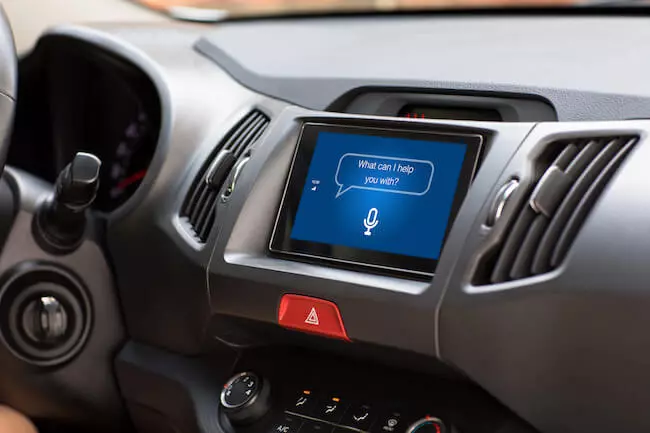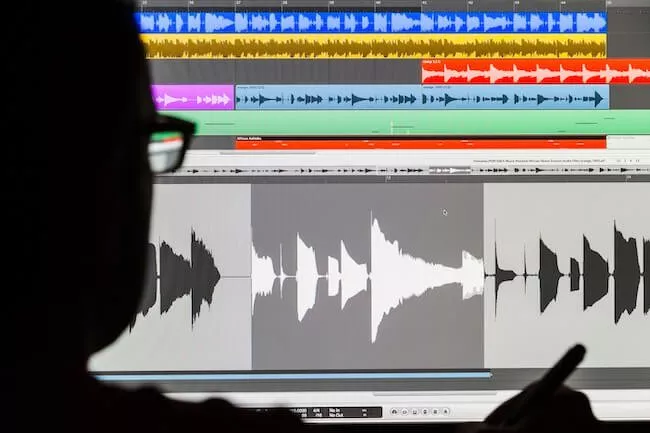 As an ADI Alliance design partner, Cardinal Peak has a wealth of experience with Analog Devices components, particularly with A2B parts, Sharc processors and Software Defined Radios (SDR) components. We have been particularly excited to see A2B gain traction over the years. Analog Device’s A2B (Automotive Audio Bus) moved from the car to the broad market in 2019 when ADI started incorporating A2B into a variety of their broad-market parts such as the SHARC microprocessors. With these new parts, we have seen A2B start being adopted in other markets as it addresses a variety of common audio product design engineering challenges. Cardinal Peak first gained experience with A2B with our automotive customers and has since incorporated it into designs in other markets as outlined later in this brief.
As an ADI Alliance design partner, Cardinal Peak has a wealth of experience with Analog Devices components, particularly with A2B parts, Sharc processors and Software Defined Radios (SDR) components. We have been particularly excited to see A2B gain traction over the years. Analog Device’s A2B (Automotive Audio Bus) moved from the car to the broad market in 2019 when ADI started incorporating A2B into a variety of their broad-market parts such as the SHARC microprocessors. With these new parts, we have seen A2B start being adopted in other markets as it addresses a variety of common audio product design engineering challenges. Cardinal Peak first gained experience with A2B with our automotive customers and has since incorporated it into designs in other markets as outlined later in this brief.
A2B basics: What is the jitter, latency and bandwidth of A2B?
Fundamentally, A2B is a daisy-chained, single twisted pair, bi-directional data bus that is ideal for supporting multiple channel audio with no jitter and extremely low, fixed latency (50 µs). By ensuring simultaneous sampling and delivery of data on all system nodes for each frame, A2B technology delivers deterministic and very low, sub-50 microsecond (µs) latency. Ideal for transporting digital audio, A2B features a configurable 44.1 kHz or 48 kHz frame rate and up to a 50 Mbps bandwidth to deliver truly superior audio quality relative to analog connections.
Overview of A2B in Automotive Applications
The reason this solution is compelling in automotive applications is because of the proliferation of distributed infotainment, voice, and noise cancellation in modern cars. Keep in mind that for voice and noise cancellation that low latency or minimal delay is very important. The figure below contrasts the old solution to an A2B implementation. For those not working on automotive products every day, the figure highlights the plethora of connections in a modern car. Everyone is familiar with the head unit and the distributed speakers/sub-woofer, but in addition, you also find a series of microphones distributed throughout the car that are used for road noise reduction in the cabin as well as tuning the audio, along with microphone arrays in both the front and back seats for voice control and hands-free calling. The left side of the figure is the traditional approach and the right side is the A2B solution. Note the simplification in the wiring harness at the bottom of the figure.
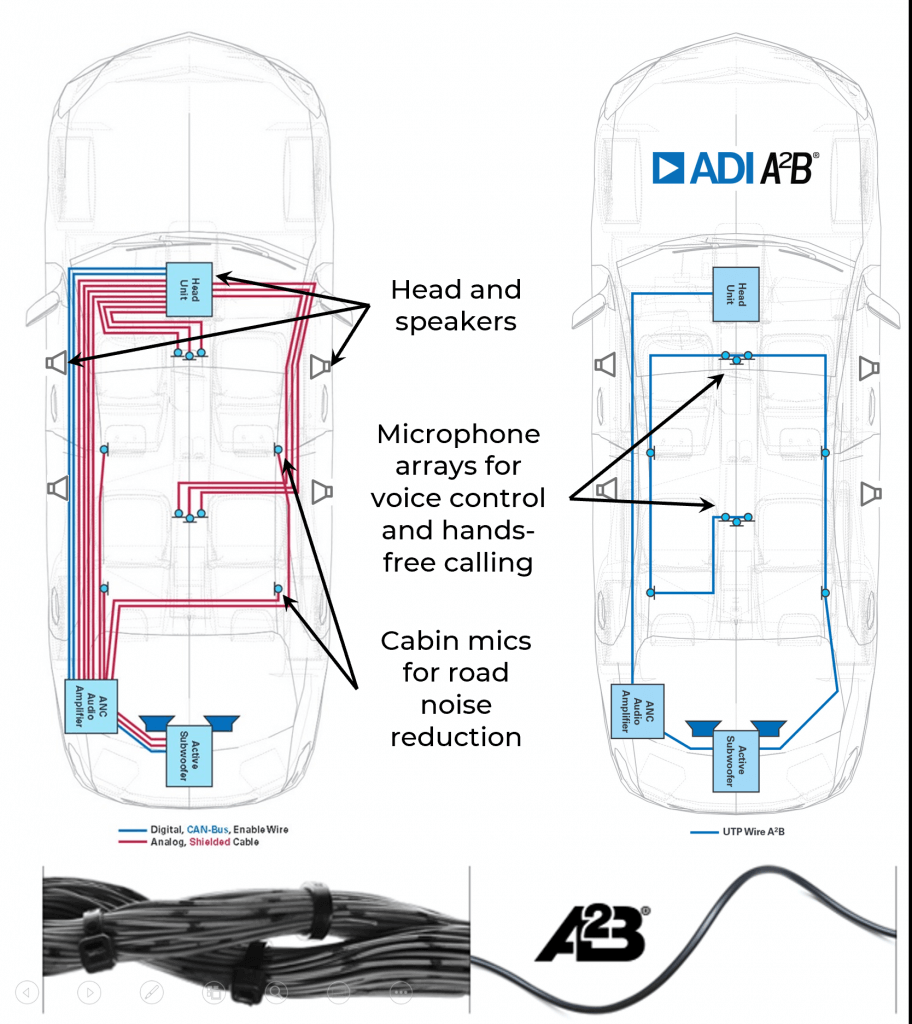
By leveraging A2B, the Cardinal Peak team eliminated wiring complexity and the need for multiple processors, significantly lowering development costs and maintenance challenges in audio systems.
In practice, A2B has several other advantages beyond those described above (which included simplified wiring, no jitter, low latency). While A2B doesn’t need to be used just for audio, we do see that distributed audio (speakers, microphone arrays, etc.) is a growing need in a variety of markets thanks to the advances in voice control (beam forming, echo cancellation, etc.). Working in both the voice control space as well as the Pro Audio market, we have a deep appreciation for maintaining audio quality with extremely low latency.
We see another other key design aspect of A2B as the ability to communicate audio and other data simultaneously with GPIO. This means end devices do not require separate processors. While processors might not be expensive these days, having multiple processors in a system adds complexity with both inter-processor communication as well as keeping firmware revisions on the different processors in sync. Driving GPIO on secondary end-devices from a primary device is a great simplification that lowers NRE, BOM, long term maintenance, and likely reduces future user complaints. The figure below illustrates this feature.
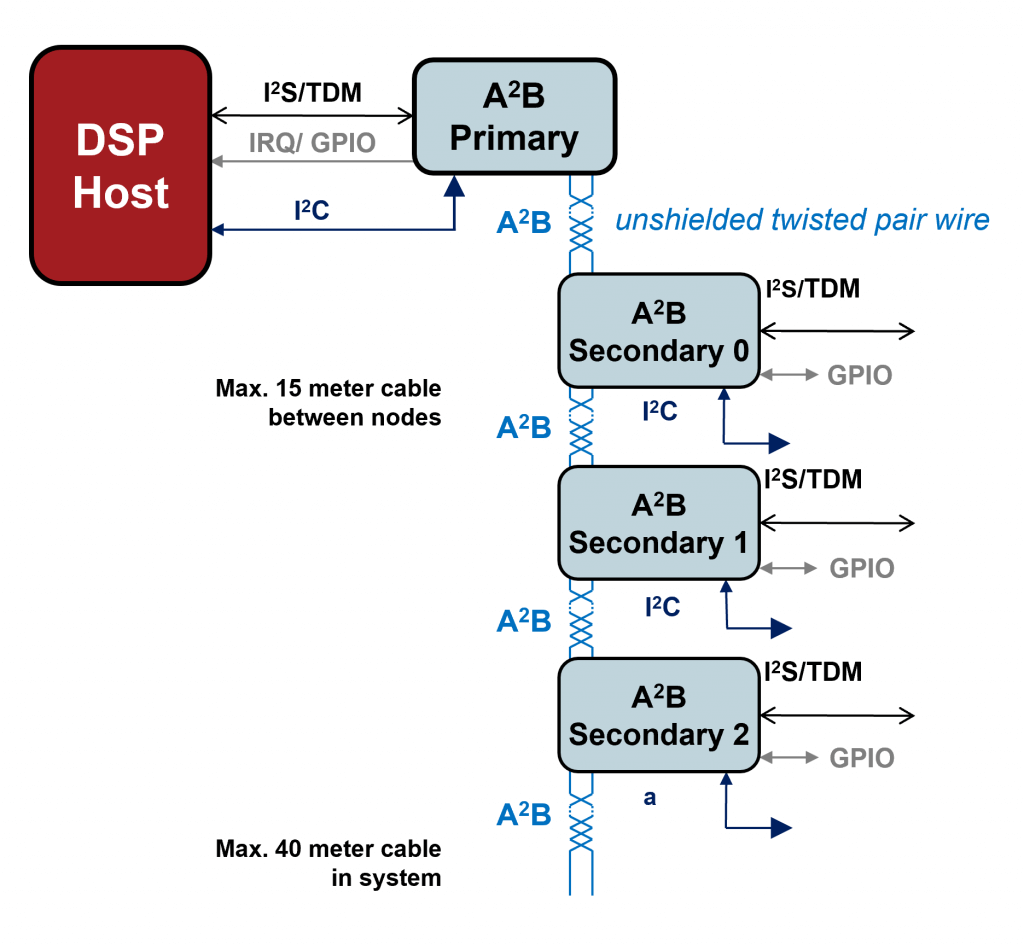
Cardinal Peak’s Automotive and Entertainment A2B Project Experience
As mentioned earlier, Cardinal Peak has done a series of projects which utilize A2B.
For a gaming customer, we developed a high-speed, low latency, 12 channel bi-directional audio network using A2B. This project included both hardware and software development.
For an original equipment automotive amplifier manufacturer, we helped with a series of projects.
- The goal of the first project was to provide noise cancelling in the cabin of a car. This required many sensors throughout the cabin including microphones located at several locations. A2B was an ideal solution as low latency and low jitter are essential for noise cancellation technologies and cars are a particularly challenging environment for running large numbers of analog wires. Once the A2B network was configured, the network was completely transparent to our DSP engineers working on the algorithms.
- Next, we were asked to work on audio systems that required fault tolerance along with fault isolation to improve overall reliability. One of the main goals was to minimize the development costs associated with required modifications of the amplifier system for different automotive manufacturers. To achieve this goal, we reduced the amount of code that needed to be modified to support an A2B network. A key design effort was to separate critical sensors onto their own bus, this required the design of multiple A2B networks acting as one. This increased system reliability by reducing the number of fault cases in critical code. The design separated out the infotainment systems from the active noise cancellation systems. The goal was to isolate the DSP algorithm engineers from the physical network configuration, allowing the systems engineers to make any required changes without requiring code changes.
- Another facet of the project was porting Analog Devices A2B software framework onto our client’s custom hardware. By doing this, we enabled the design team to use ADI’s graphical diagnostic and tuning tools (SigmaStudio) to perfect the systems. This allowed the designer to use SigmaStudio to draw their network of devices and connect them together. The SigmaStudio tool allowed us to evaluate and test a network, in real-time, changing parameter settings in the hardware to achieve the desired behavior. We were able to create multiple network combinations of remote amplifiers, microphones, and accelerometers, with little to no software changes to the product.
- Finally, given our deep understanding of the hardware, we were able to tailor network discovery modes to suit the client’s needs. We focused on a balance between quick boot times and software complexities.
A2B uses in Transportation, Live Performance, Conferencing and Other Markets
Other markets where we see an advantage for A2B include:
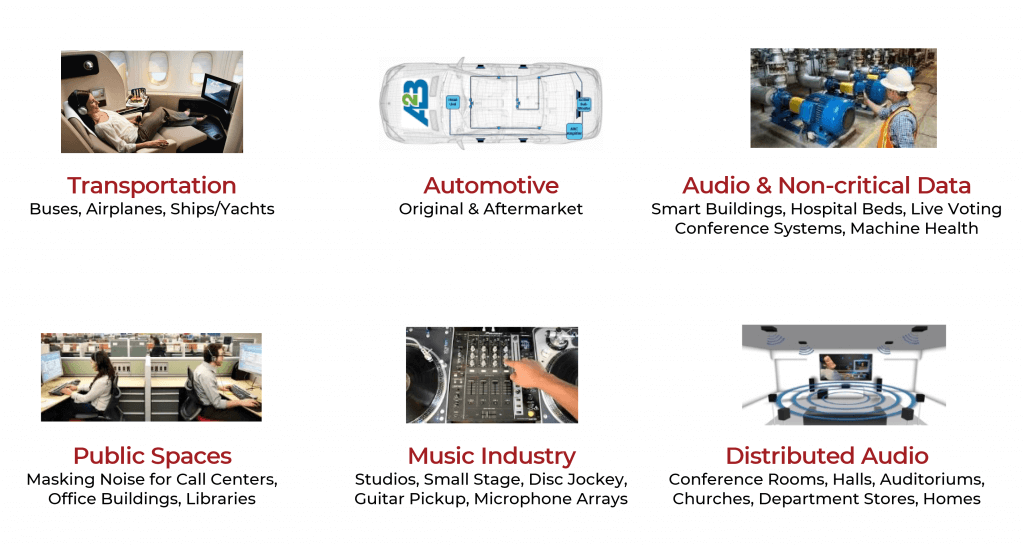
Transportation
Similar to the automotive need where A2B simplifies wiring and control of multiple audio sources and sinks. We see applications in research labs and in control systems where the lack of jitter makes it ideal.
Music Industry
Pro audio has a variety of application including live performing musicians. Not only does it simplify the complex wiring found on stage and at the mixing station, it does so with latency low enough that the musicians will not hear the delay.
Distributed Audio
The application for conference rooms is self-evident, although for larger spaces or for campus wide systems it is necessary to bridge to longer-range networks such as AES67 or Dante (both of which Cardinal Peak has experience with).
As an Analog Devices design partner for A2B, if you have an application in any of the areas above (or others) that you would like to discuss, please contact us.
For background and additional information, check out our other articles on A2B technology:
- What is Analog Devices’ Automotive Audio Bus (A2B) and How is It Used?
- Unleashing A2B Technology For Conferencing, Live Audio And Other Applications
- Designing Audio Products with A2B and SHARC
- Taking Analog Devices A2B Technology Beyond Automotive Applications
- From GPTP To Buffer Overflow: Ensuring Seamless Automotive Audio
- The Future Of Fault Detection: A2B Technology For Automated Equipment
- Cardinal Peak Named Analog Devices Design Partner


